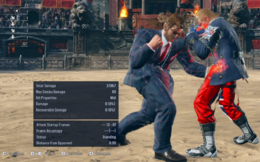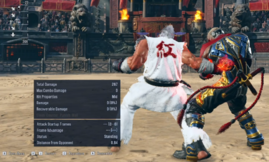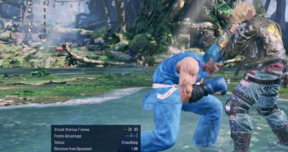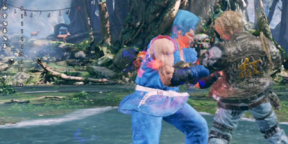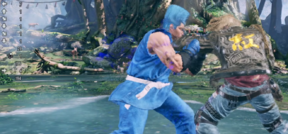m (→Pauldash) |
No edit summary |
||
| Line 1: | Line 1: | ||
{{Navbox Paul}} | {{Navbox Paul}} | ||
== Deep Dive Startup Delay/Input Lockout == | |||
There is a 10-frame window after Deep Dive where Paul's movement is locked and attack options (both ws and DPD) start up 1-10 frames slower. | |||
<gallery> | |||
Dpd iws1.png|iWS1 (normally i15~16) hits on frame 25 when input immediately after Deep Dive. | |||
Image23.png|DPD.2 (normally i15) hits on frame 25 when input immediately after Deep Dive. | |||
</gallery> | |||
<gallery> | |||
Dpd block attempt frame 9.png|Paul cannot block in the 10-frame lockout window following a Deep Dive input. | |||
Dpd block attempt frame 10.png|Paul returns to a standing state and is able to block again at the end of this period. | |||
</gallery> | |||
An immediate press after DPD (ws1/ws2/ws3/ws4/DPD.2/DPD.4/DPD.3+4) will add 10 frames of startup to that move. This delay decays gradually for each frame following the DPD input, until startup eventually returns to normal. For example: | |||
* ws1 startup is i15~16 | |||
* d, df, d, df, ws1 startup is i25~26 | |||
* d, df, d, df, (4f delay), ws1 startup is i21~22 | |||
* d, df, d, df, (5f delay), ws1 startup is i20-21 | |||
And so on until 9f delay (10f after DPD), when ws1 startup is back to the regular i15~16. | |||
The Frame Data display in Practice/Replay mode does not account for these additional frames and shows only the attack's normal startup. | |||
This decaying startup delay is similar to that of sidestep moves, but with the additional constraint that Paul's only bufferable movement in this state is u (which cannot be used to immediately crouch cancel - see next section for details). | |||
Lockout frames begin as soon as the initial crouch dash is canceled into Deep Dive. Delay between CD/QCF and DPD inputs does not seem to matter. | |||
This delay makes Deep Dive a more committal approach than Paul's regular crouch dash and has practical drawbacks in both neutral and pressure. Be mindful of this extra startup before attacking with a long-range iWS1,2 or DPD.2, and avoid using DPD inputs for iWS at closer ranges whenever possible. | |||
=== Crouch Cancel Does Not Avoid Lockout === | |||
Crouch canceling to avoid the DPD delay window and immediately return to neutral does not seem possible. The sidestep from crouch cancel will not come out until 10 frames after DPD, and no other directional movement or attack can be executed or buffered in the interim. | |||
'''This includes b, meaning you cannot block for at least 10 frames after DPD.''' | |||
<gallery> | |||
DPD CC block vs mid.png|Mids cannot be blocked during the lockout window. | |||
DPD CC block vs high.png|Highs will still be evaded. | |||
</gallery> | |||
== 1+2 Charge Cancel == | == 1+2 Charge Cancel == | ||
Revision as of 15:26, 25 May 2024
| Paul |
|---|
Deep Dive Startup Delay/Input Lockout
There is a 10-frame window after Deep Dive where Paul's movement is locked and attack options (both ws and DPD) start up 1-10 frames slower.
-
iWS1 (normally i15~16) hits on frame 25 when input immediately after Deep Dive.
-
DPD.2 (normally i15) hits on frame 25 when input immediately after Deep Dive.
-
Paul cannot block in the 10-frame lockout window following a Deep Dive input.
-
Paul returns to a standing state and is able to block again at the end of this period.
An immediate press after DPD (ws1/ws2/ws3/ws4/DPD.2/DPD.4/DPD.3+4) will add 10 frames of startup to that move. This delay decays gradually for each frame following the DPD input, until startup eventually returns to normal. For example:
- ws1 startup is i15~16
- d, df, d, df, ws1 startup is i25~26
- d, df, d, df, (4f delay), ws1 startup is i21~22
- d, df, d, df, (5f delay), ws1 startup is i20-21
And so on until 9f delay (10f after DPD), when ws1 startup is back to the regular i15~16.
The Frame Data display in Practice/Replay mode does not account for these additional frames and shows only the attack's normal startup.
This decaying startup delay is similar to that of sidestep moves, but with the additional constraint that Paul's only bufferable movement in this state is u (which cannot be used to immediately crouch cancel - see next section for details).
Lockout frames begin as soon as the initial crouch dash is canceled into Deep Dive. Delay between CD/QCF and DPD inputs does not seem to matter.
This delay makes Deep Dive a more committal approach than Paul's regular crouch dash and has practical drawbacks in both neutral and pressure. Be mindful of this extra startup before attacking with a long-range iWS1,2 or DPD.2, and avoid using DPD inputs for iWS at closer ranges whenever possible.
Crouch Cancel Does Not Avoid Lockout
Crouch canceling to avoid the DPD delay window and immediately return to neutral does not seem possible. The sidestep from crouch cancel will not come out until 10 frames after DPD, and no other directional movement or attack can be executed or buffered in the interim.
This includes b, meaning you cannot block for at least 10 frames after DPD.
-
Mids cannot be blocked during the lockout window.
-
Highs will still be evaded.
1+2 Charge Cancel
1+2 (hold 16-34f) > f~u~b (release 1+2)
Useful for baiting big keepout attacks or locking down defensive players.
Can be used throughout a set to condition opponents. If they begin to challenge the 1+2 cancel, release a level 2 charge for 42 CH damage (48 with Heat) and huge knockback, or cancel into SWA with b to evade and punish their attack.
1+2 charge cannot be canceled before frame 16 or after frame 35, so use with caution.
Pauldash
d,df~d,df~u > repeat
Quickly cancel crouch dash into Deep Dive with df, crouch cancel Deep Dive with u, and repeat for Paul's pseudo-wavedash/snake dash.
Good for oki (DPD will realign and chase down techs to either side) and quick ws1,2/DPD.4 mid-range pressure (high evasion from CD/DPD can create whiffs against some keepout buttons).
Be aware of Deep Dive's startup delay and input lockout, which can cause unintentional jumps if crouch cancels are executed too quickly.
BT Tech Trap
- [86] H.qcf+2 WBl! > SSL~F > SSL > qcf+1 (x3) > SWA.1+2 T! > dash > UF
- [+99] ws1,2~b > SWA.1+2 > 3,2~b > SWA.1+2 T! > H.qcf+2~f > qcf+2
Forward jumping against a backturned opponent in Tornado state can force tech attempts to recover backturned.
